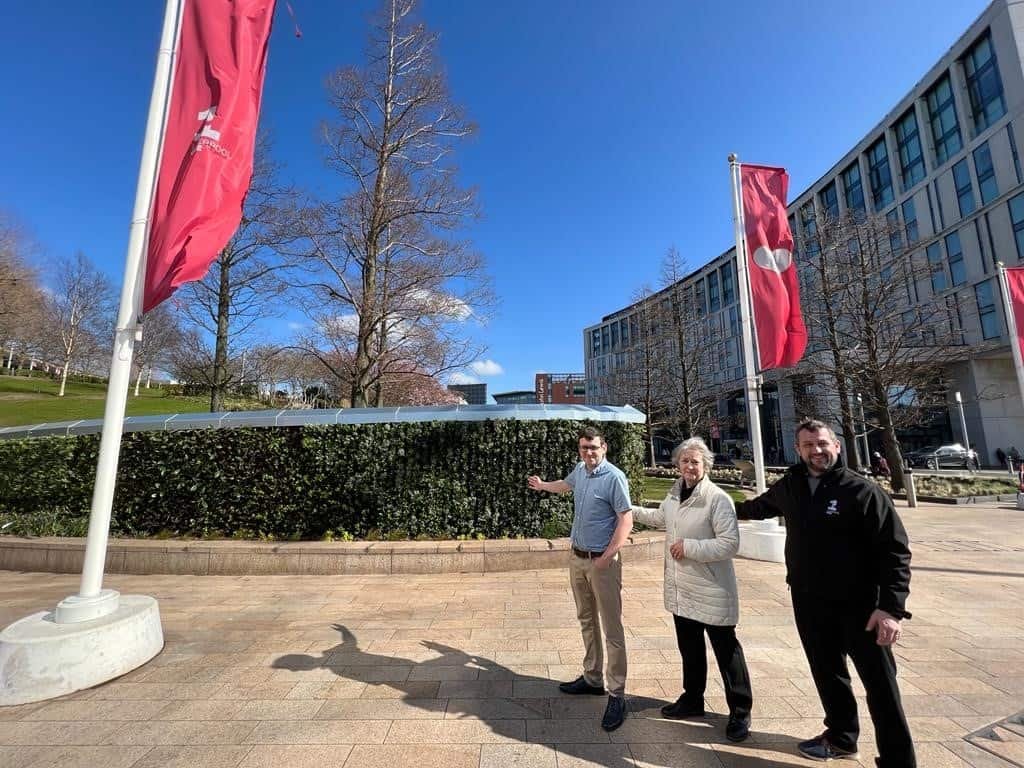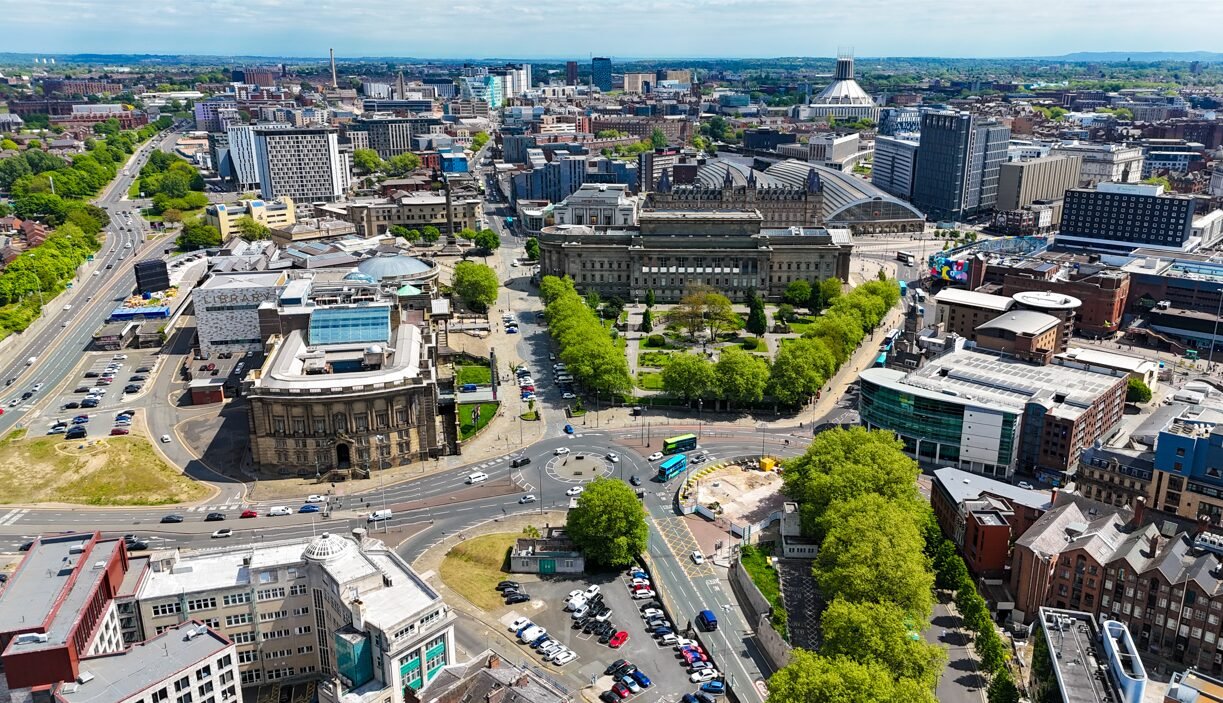The Liverpool ONE living wall, featuring almost 8,000 plants, as a part of a bid to boost bio-diversity in the city centre, has officially been unveiled.
Measuring 27 metres long and up to 2 metres high, the stunning feature stands at the entrance of Liverpool ONE’s Chavasse Park – facing the Royal Albert Dock – and boasts almost 8,000 pollinator friendly plants and 24 different species.
The freestanding installation, which will form part of the existing nature trail in the Green Flag accredited Chavasse Park, is part of an innovative project to create a series of wildlife-friendly “environmental stepping stones” across a city centre recognised for having one of the lowest percentages of greenspace in the UK.
As well as having been specifically designed to encourage insects back into the city centre and to help clean the air, the project is part of a wider programme aimed at developing the city’s resilience to climate change.
The visually striking structure, predicted to be seen by more than 10 million people over the next 12 months, will provide a natural physical barrier to traffic pollution along The Strand by re-dispersing vehicle pollutant gases and fine exhaust particles.
Every year the living wall is predicted to (approximately):
• Extract 110.5kg of carbon
• Produce 144.5kg of oxygen
• Extract 230kg of gas
The fledgling urban wildlife haven is also fitted with smart technology, has its own climate sensors and irrigation system and will absorb up to 15 decibels of sound at any one time.
The living wall also complements the redevelopment of The Strand, which is undergoing a major redesign to improve traffic flow, road safety and air quality. New trees and planting on The Strand are also helping to reduce the likelihood of future surface water flooding.
The living wall project is a partnership between Liverpool City Council, The Mersey Forest and The University of Liverpool. Funding has come from the EU Horizon 2020 project Urban GreenUP, which seeks to tackle environmental issues through innovative natural solutions, and from the Green Recovery Challenge Fund through the ‘More from Trees’ project managed by the Mersey Forest team.
Over the next two years, a team from Mersey Forest will monitor the environmental, ecological and wellbeing performance and impact of the wall and its development as a mini ecosystem.
The Liverpool ONE living green wall, which is populated with evergreen plant species such as Euonymus gaiety, Carex pendula and Carex testacea, is the third such feature to spring up in the city, with one at Parr Street Car Park and the other at St Johns Shopping Centre, which at 60m is believed to be one of the longest of its kind in the UK.
Other eco-friendly installations funded through the £3.5m URBAN GreenUP programme include spectacular planted floating islands at Sefton Park and Wapping Dock. More than 140 trees have also been planted across the city centre on key roads, such as The Strand and Lime Street.
The URBAN GreenUP programme forms part of a wider Liverpool city council climate change response to deliver on its climate change declaration in 2019 and to rebalance the city’s carbon footprint and achieve a net zero output by 2030.
Councillor Dan Barrington, Liverpool City Council’s Cabinet Member for Environment and Climate Change, said:
“I’m thrilled to see this new living green wall at Liverpool ONE. It’s another vital step in greening up our city centre and improving our resilience to climate-change.
“Along with a host of other connected nature-based schemes, this living wall will have a positive impact on both wildlife and us humans too – from better air quality to our wellbeing. I’m sure it will raise a smile for all who see it because we know plants and flowers lift our mood. The science is proven that our mental health is boosted when we are exposed to the beauty of nature.
“There’s a lot more we can do but the Urban GreenUP programme with the Mersey Forest is slowly but surely changing the look and feel of Liverpool. And our efforts now to address climate change, however big or small, are absolutely critical if we want future generations to enjoy and admire our city and the natural world.”
Paul Nolan, Director of The Mersey Forest, said:
“Liverpool is leading the way in showing how cities can use green infrastructure to improve the quality of life and place. Liverpool ONE has been a great supporter in establishing more nature in the city and as part of Urban GreenUP and Green Recovery, it is great to see the new wall in place.”
Iain Finlayson, Estate Director at Liverpool ONE, said:
“We welcome the addition of the green wall to Chavasse Park. It supports our commitment to continually enhance our biodiversity and maintain our green spaces. We are delighted to work with such experienced partners in the city and to be part of a network of pioneering sustainable cities across Europe.
“As a Green Flag accredited space, Chavasse Park is home to many plants and wildlife and has become a real go-to place for fresh air and ‘me time’ within the city, especially during the last two years when we have all come to appreciate the outdoors so much more. The new green wall will contribute to improving the wellbeing of our visitors, staff and residents which is at the heart of our commitment to communities and the environment.”
Steve McIntyre, Principal Urban Environment Consultant at ANS Global, which designed the living wall, said:
“Our brief to enhance the entrance to Liverpool ONE was to consider local biodiversity, so we decided to use our soil-based living wall system which provides greater environmental benefits. The plant palette was selected with a lot of care, as the site of the greening is very exposed with windy and saline conditions. We also had to cater to all aspects as the living wall faces all four sides. Therefore, the plants had to range from suiting full shade, to full sun. Overall, a great challenge and we can’t wait to see it flourish over the Spring and Summer.”
This living green wall project is also part-funded by the government’s Green Recovery Challenge Fund, which forms part of the nation’s wider green economic recovery, jobs and skills package to restore nature and tackle climate change.










